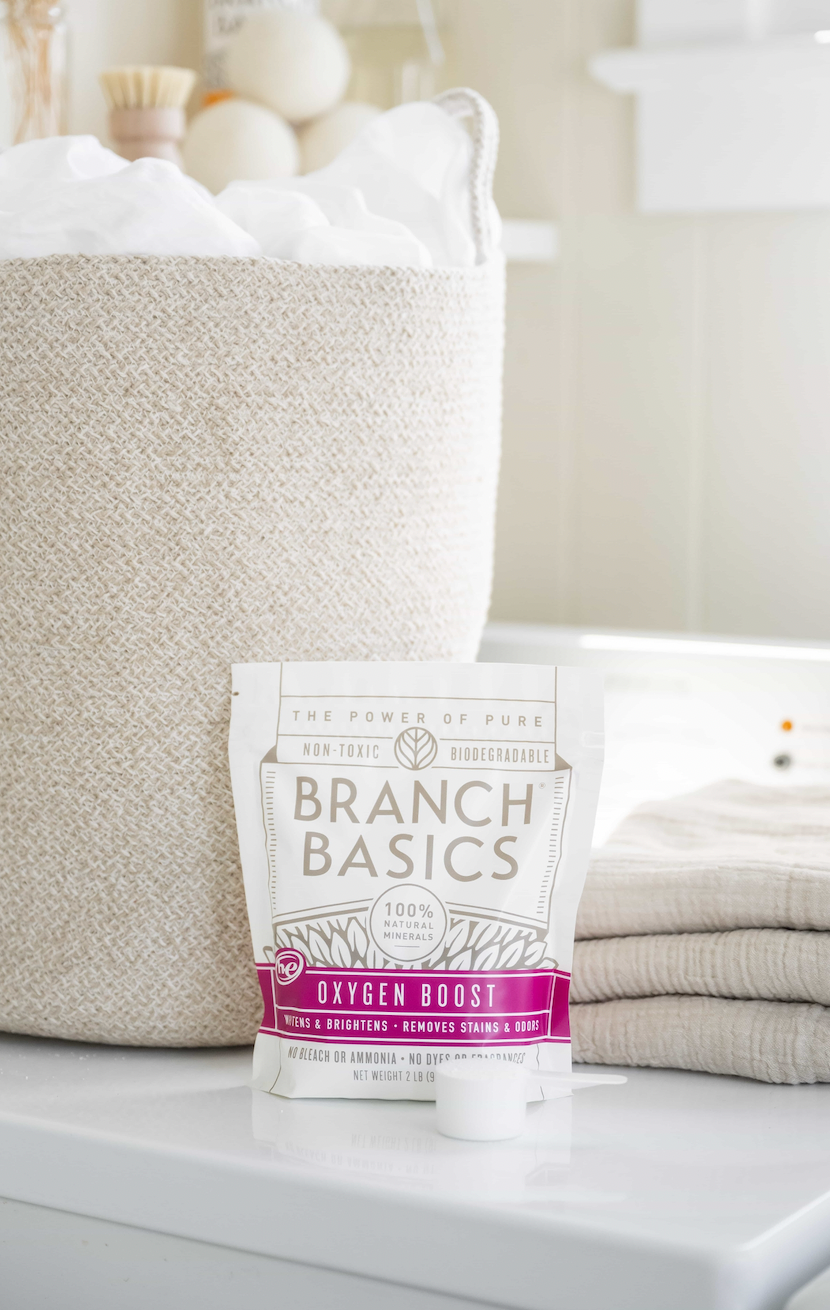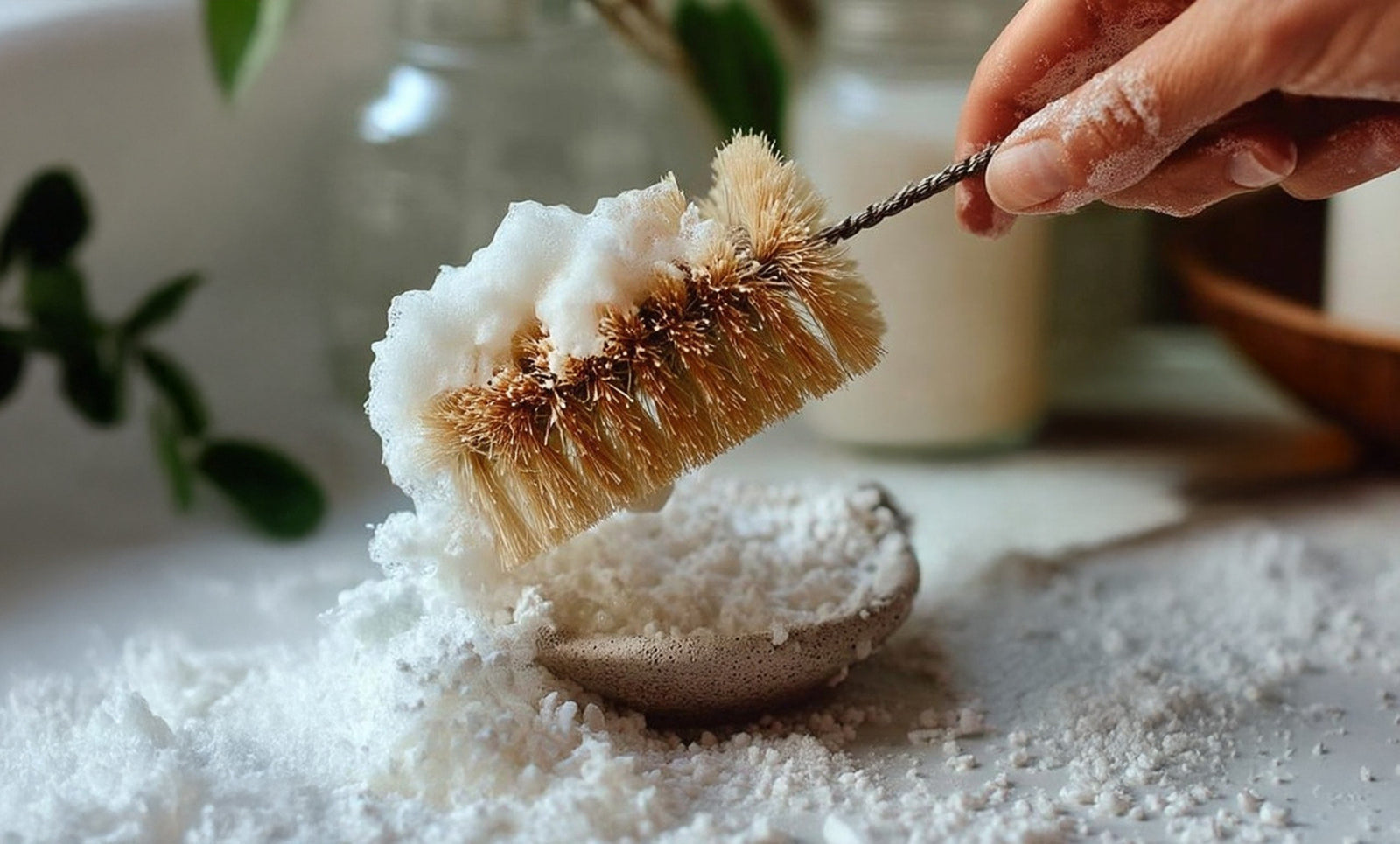Can You Be Allergic To Bleach? Try These Safe Alternatives

Can you be allergic to bleach?*
Absolutely. As one of the most dangerous chemicals in the home, bleach allergies are not uncommon.
You may also have a bleach sensitivity, which may not cause a full-on allergic reaction but creates other symptoms such as headaches, eye irritation, or respiratory problems.
No matter how you slice it, allergic or not, active or even passive bleach exposure is harmful to everyone and can cause various ill health effects.
Fortunately, safer and gentler bleach alternatives offer the same or similar benefits—such as whitening, brightening, stain removal, mold removal, and disinfecting—without the risks.
*It is essential to realize that chlorine bleach is a harmful chemical to everyone, many of whom might quickly respond with, “Oh, it doesn’t bother me!” If so, they are fortunate enough to have detoxification pathways that provide more efficient clearance of toxicants.
Still, the fact of the matter is that the body burden of all American people is impacted by exposure to toxicants like bleach.
What You Should Know About Bleach Allergies
We all know bleach is pretty toxic look at the warning labels on the bottle!). Yet, it’s also one of the most common ingredients used in cleaning and laundry products.
Its ubiquitous use creates the appearance of a safe product when the exact opposite is true.
In terms of allergies, research has shown that bleach-based cleaners contain the greatest concentration of VOCs of all cleaning products.
VOCs, also known as Volatile Organic Compounds, are the smells that come from natural and artificial products.
For instance, the scent of a rose is an example of a natural VOC, while the scent of bleach or new carpet is an unnatural or synthetic VOC.
According to the Environmental Protection Agency, harmful VOCs impact everyone’s healthand may cause:
- Allergic skin reactions
- Brain fog or cognitive impairments
- Damage to the liver, kidneys, and central nervous system
- Dyspnea
- Dizziness
- Eye, nose, and throat irritation
- Headaches
- Loss of coordination
- Nausea
- Nosebleeds
- Respiratory issues, especially for those with asthma or other lung conditions
- Shortness of breath
- Vomiting
Bleach is also an asthmagen, a substance that can cause or trigger asthma attacks.For example, research has shown passive exposure to bleach, such as through cleaning products, can cause an increased risk of respiratory illness and other illnesses in children. Asthma is a leading cause for chronic illness in children!
Additional research has shown that babies exposed to synthetic chemical cleaning and laundry products, including those with bleach, during the first three months of life have a higher risk of asthma than those who were not exposed.
We discuss much more about the toxicity of bleach and the allergenic nature of other cleaning and laundry ingredients in:
5 Bleach Alternatives
If you suspect a bleach allergy or sensitivityor want to eliminate a highly toxic chemical from your home, bleach alternatives are the answer.
Here are five bleach alternatives that will remove stains, whiten whites, disinfect, kill mold and mildew, and remove germs safely and naturally.
1. Branch Basics
At Branch Basics, our mission is to make it simple to switch from toxic products, like bleach, to human-safe and eco-friendly cleaners and laundry products.
For example, our signature all-in-one Concentrate is designed to replace all cleaning products with harmful chemicals, including bleach-based all-purpose and bathroom cleaners, laundry detergents, and stain removers.
Our Concentrate, which is diluted with water to create various cleaners, powers through dirt, grease, grime, and soil while removing germs, versus killing them, for a complete clean that lasts. (In subsequent We’ll discuss options for safer and more natural disinfectants in subsequent sections.)
In addition, Branch Basics Oxygen Boost is a fantastic mineral-based bleach alternative for removing stains, cleaning tile and grout, as a laundry booster and whitening agent, a soaking aid, and a scouring agent.
Oxygen Boost can be used alone or combined with All-Purpose or Bathroom for extra (and safe!) bleaching and scouring power.
To learn more about Branch Basics’ all-in-one human-safe cleaning system, see: How To Get Started With Your Branch Basics Kit.
2. Baking Soda
Most households keep baking soda for baking and deodorizing the fridge. However, did you know this versatile product is also an awesome bleach alternative?
You can use it for:
- Removing stains: Either mixed with water as a paste or a soaking aid.
- Whitening your clothes: Add 1 cup to your washing machine.
- Cleaning tile grout: Mix with a bit of Branch Basics All-Purpose or Bathroom or liquid castile soap and apply with a grout brush or toothbrush.
- As a no-scratch scouring agent: On pot and pans, surfaces, stoves, ovens, etc.
- Making a DIY soft scrubbing cleaner: Search “Baking Soda Castile Soap DIY Cleaner” for various recipe combinations.
Get more tips in: Cleaning With Baking Soda: 12 Surprising Uses.
3. Peroxide
3% hydrogen peroxide in the brown bottle is an exceptional bleach alternative because it whitens, cleans, removes stains, kills mold and mildew, and disinfects without harmful fumes.
How well does it work as a disinfectant? Research suggests well.
A 2018 study showed that 3% hydrogen peroxide was more effective at killing certain germs and viruses than mainstream Quat-containing disinfectants (Quats are a highly toxic chemical used in disinfectants).
The key is first to remove germs using a surfactant or soap-based product, like Branch Basics, then follow up with 3% hydrogen peroxide and allow to dwell for a few moments.
You can also use it with distilled white vinegar for disinfecting, provided they are used separately (spray one, remove, then spray the other) and stored in separate bottles.
Get our full human-safe disinfecting tutorial in How To Naturally Disinfect Surfaces, Complete Guide.
Pro tip: We like to keep a trigger sprayer on our Hydrogen Peroxide bottles for ease of use (and because it should be stored in its original dark brown container to prevent product breakdown).
For the full story on why hydrogen peroxide is considered a non-toxic product and how to use it, see:
How To Use Hydrogen Peroxide As a Safer Alternative for Cleaning, Disinfecting, Laundry, & More.
4. Sunshine
As any cloth-diapering parent or off-grid enthusiast will tell you, sunshine is nature’s most natural bleach alternative!
We love using the full summer sun to whiten sheets, towels, and other clothing and help remove stubborn stains. However, you can use the sun in the other seasons too: just keep in mind it won’t be as strong.
When sunning clothing, we recommend turning colored clothes inside out and checking them frequently to avoid discoloring. You can be less vigilant about white clothing. Make sure to shake clothes out to remove dust and bring clothes you are sunning inside before sundown to avoid the dew.
Sunning is also an excellent way to speed the off-gassing/outgassing process of new household items and hand-me-downs that have been washed in fragranced detergent.
5. Lemon Juice
We love using lemon juice to bleach out stains on countertops, clothing, and other surfaces.
The natural citric acid in lemon juice has a powerful bleaching effect and some sanitizing properties.
Fun fact: You can also use lemon juice to lighten your hair. Just spray some on and go out into the sun, or use a blow dryer to activate its natural bleaching properties.
Note that conditioning is essential after lemon juice hair bleaching, as it can be drying.
Get more natural bleach alternative options in:
- 7 Human-Safe and Earth-Friendly Laundry Bleach Alternatives
- 9 Natural Alternatives To Bleach For Disinfecting
- Most Effective Kitchen Cleaners Without Bleach
What is the Difference Between an Allergy vs. Sensitivity?
Many people wonder about the difference between an allergy and sensitivity, so here it is.
An allergic reaction occurs when the immune system releases a specific IgE antibody to bind to an allergen, like bleach or something else, and causes a specific and consistent or reproducible reaction, such as hives, wheezing, or anaphylaxis.
A sensitivity does not cause the same immune response and may cause consistent or inconsistent symptoms such as headaches, rashes, brain fog, mood swings, itching, coughing, etc.
People who overtly react or are sensitive to harmful chemicals, for example, may be diagnosed with Idiopathic environmental intolerance (IEI), formerly known as Multiple Chemical Sensitivity Disorder. Our co-founder, Marilee Nelson, has worked extensively with people suffering from IEI.
Unfortunately, it’s often difficult to know if you have a bleach allergy or sensitivity unless the reaction is life-threatening. However, you can discuss testing options with your doctor or healthcare practitioner.
In either case, avoidance is the best way to stop future symptoms.
Unleash The Cleaning Power Of Branch Basics
We hope this article has given you all the knowledge and tools you need to break up with bleach and prevent any future symptoms or reactions.
If you want to try Branch Basics as a human-safe, earth-friendly bleach alternative, check out our Starter Kits.
Each Premium Starter Kit, available in refillable plastic or glass, contains a bottle of Branch Basics Concentrate and Oxygen Boost.
With that one bottle of Concentrate, you can make:
- 3 bottles of All-Purpose at $3.09 each
- 3 bottles of Bathroom at $6.18 each
- 3 bottles of Streak-Free at $0.49 each (for real!)
- 64 Loads of Laundry at $0.26 per load
- 3 bottles of Foaming Wash at $3.09 each
That’s a whole lot of cleaning power packed into one kit!
For more information on Branch Basics ingredients, formulas, and philosophy see: How Branch Basics Is A Healthy And Sustainable Cleaning Line.
For more educational resources on identifying, removing, and replacing harmful products in your home, check out our blog, Podcast, and Toss The Toxins Online Course.
Categories

Marilee Nelson
Marilee Nelson is an Environmental Toxins expert who has spent nearly 30 years advocating for the chemically-sensitive and chronically-ill. She is a Board Certified Nutritionist, Certified Bau-Biologist and Bau-Biology Inspector and specializes in Food As Medicine. She has helped thousands of families and individuals identify, heal and recover from toxic exposures and is on a mission to revolutionize the way American families view their health.








